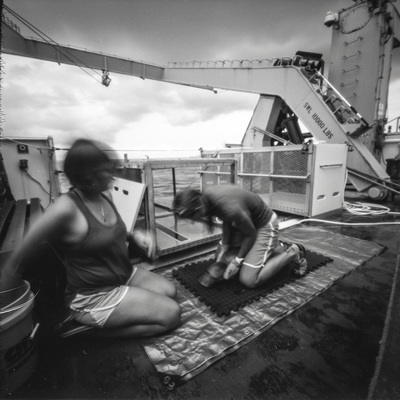H A W A I I A N M O N K S E A L R E S E A R C H P R O G R A M
A critically endangered Hawaiian monk seal green from algae after a long period at sea, rests on a bed of equally green Akulikuli; a native plant found in the Northwestern and Main Hawaiian Islands / Southeast island / Pearl & Hermes / Papahānaumokuākea Marine National Monument / 2016
|
A weaned pup hauls out on shore @ Seal-Kittery / Pearl & Hermes Atoll
|
For six months during the spring and summer of 2016, I teamed up with NOAA’s Hawaiian Monk Seal Research Program [HMSRP] as artist in resident. After a month of training in Honolulu, I worked as an embedded member of a three-person field camp at Pearl & Hermes atoll in the Northwestern Hawaiian Islands [NWHIs], some 1200 miles from Honolulu. During the residency, I worked as a field biologist collecting important population assessment data on the Hawaiian monk seal. I used the experience of working as a field biologist to inform a new body of work focused on wildlife conservation and environmental stewardship. |
The Hawaiian monk seal is endemic to Hawaii and with roughly 1,300 individuals remaining, one of the most endangered marine mammals in the world. The HMSRP has been working to help recover the Hawaiian monk seal for three decades and it is estimated that about 30% of the population is alive today due to their efforts. With a number of one-of-a-kind recovery activities including translocations and vaccinations, the HMSRP is the most proactive marine mammal recovery program on the planet.
Hawaiian Monk Seal Research Program staff care for a critically ill, young Hawaiian monk seal. In mid-August, this emaciated seal was brought from Laysan island in the NWHI's to the Ke Kai Ola Hawaiian monk seal hospital in Kailua-Kona, HI. There he will be rehabilitated and then released back into the wild in the Spring of 2017. With a total population of about 1,300, the survival of the species lies in the life of every seal. Veterinarian Michelle Barbieri-Lino [right] and Veterinarian tech Angie Kaufman [left] on board NOAA RV Oscar Elton Sette. NMFS Permit No. 16332-01
|
Freshly molted juvenile Hawaiian monk seal. Hawaiian monk seals experience a catastrophic molt where they lose their fur and top layer of skin about once a year. Their new coat is shiny & silvery.
|
My interest in this research lies in the ideology that knowledge is the key to transformation and that the dialogue between art and science is imperative for a most informed and diversified understanding of life on earth. With science far too often inaccessible and unattainable, the goal of this collaboration is to bring awareness to the plight of the Hawaiian monk seal and the effects of anthropogenic climate change on the vulnerable ecosystems of the NWHIs and beyond; to learn how to take proactive action for the health and betterment of our planet.
An exhibition and accompanying catalog based on this research debuted in Ocotber, 2017 at Traver Gallery. This project is approved under the Papahānaumokuākea Marine National Monument permit No. PMNM-2016-011 and National Marine Fisheries Service permit No. 16332-01. |
The Hawaiian Monk Seal Research Program 2016 field camp @ Pearl & Hermes / Population [Human] - Three










